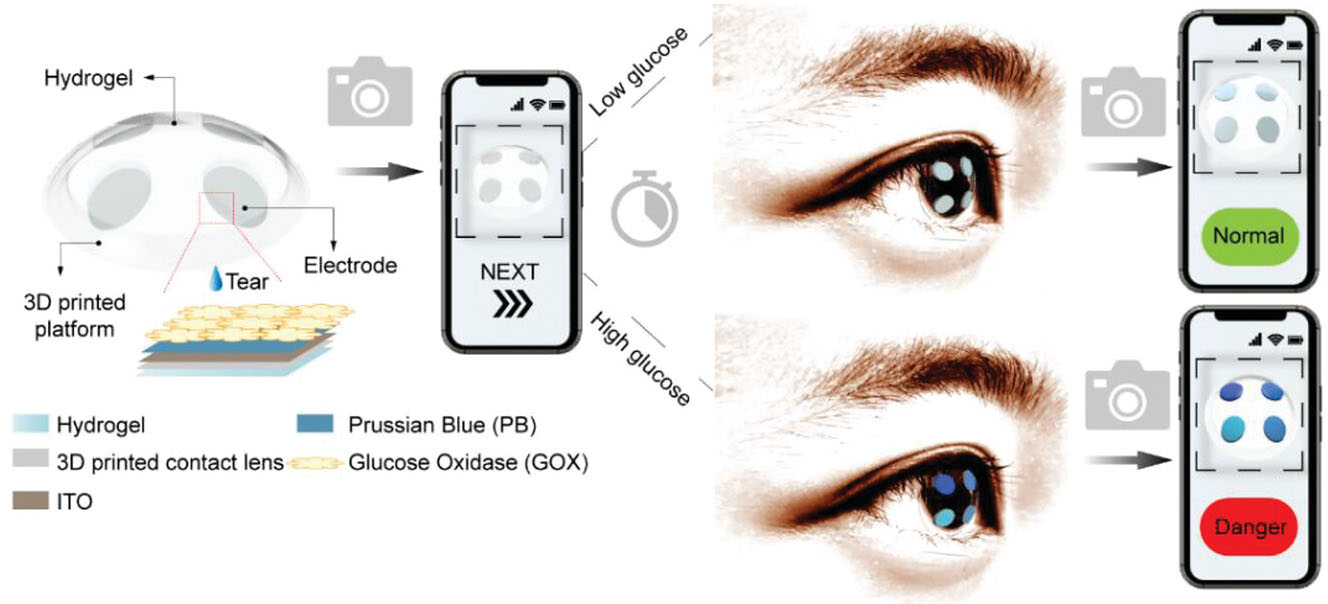| Oct 17, 2023 | |
Power-free contact lenses use color-coded tears for diabetes tracking |
|
| (Nanowerk Spotlight) Diabetes affects millions of people worldwide, requiring constant monitoring of blood glucose levels to manage the disease and avoid complications. Typically, this involves painful finger prick blood tests several times per day. Scientists have long sought a non-invasive alternative that is safe, convenient and comfortable for the wearer. | |
| Now researchers at Nanyang Technological University in Singapore report promising results from early studies of an innovative “smart” contact lens designed to detect glucose levels in tears. The power-free lenses rely on simple color changes to signal the wearer, eliminating the need for electronics or batteries. | |
| They published their findings in Advanced Functional Materials ("Power-Free Contact Lens for Glucose Sensing"). | |
 |
|
| Power-free smart contact lens system for glucose detection. a) Power-free contact lens working principle. The initialized lens is first captured with the camera, followed by putting in eyes for certain-time processing. Then the lens after the application is captured for later comparisons with the initial lens to examine the color change and glucose status. The captured photos are computationally processed to examine the color change. Results for both low and high glucose concentrations are illustrated. (Reprinted with permission by Wiley-VCH Verlag) | |
| Lead author Dr. Seok Woo Lee explained the significance of this new approach: “Previous smart contact lens designs have required electronic components and wireless power, posing potential safety hazards and comfort issues for the eyes. Our lens uses the natural chemistry of tears to trigger color changes in embedded sensor electrodes, giving a rapid visual indicator of glucose concentration.” | |
| The research team fabricated contact lenses with multiple sensor electrodes made of a transparent material called Prussian blue. This reacts with glucose byproducts in tears, changing from colorless to blue. The degree of color change correlates with glucose concentration. | |
| To cover both normal and elevated glucose levels, the team varied the thickness of the electrodes, with thinner sensors better suited for lower concentrations. The sensor regions surround a clear central zone to avoid blocking vision. | |
| After depositing the electrode materials, the lenses were encapsulated in a hydrogel polymer matrix for comfort and biocompatibility. Enzyme layers on the electrodes and a protective Nafion coating enabled repeat use after initialization. | |
| Tests showed the prototype lenses could detect a wide glucose range, from normal down to 0.05 mmol/l. By capturing and analyzing photos of the color-coded electrodes before and after use, customized algorithms predicted concentrations with excellent accuracy compared to controlled samples. | |
| According to Dr. Lee, the lenses could enable pain-free, real-time monitoring during daily activities. Users would simply apply the lenses in the morning and check colors every 20 minutes, similar to inspecting conventional lenses. Photos could document changes over time or be processed through a mobile app to quantify values. | |
| The scientists evaluated repeatability by resetting and retesting the lenses multiple times. Performance remained consistent over four cycles and after two weeks of storage. The Nafion coating and electrochemical re-initialization contributed to this reusability. | |
| While promising as an easy-to-use, self-contained system, the contact lens approach has limitations. Tear glucose lags behind blood levels, so timing is critical. The team suggests using testing schedules already proven for blood monitoring. There are also practical hurdles in developing and commercializing any tear-based glucose sensor for market. | |
| However, this early research demonstrates the potential of an eyewear-integrated diagnostic that avoids implanted electronics. The simple colorimetric approach could potentially be adapted to detect other biomarkers beyond glucose. | |
| Power-free smart contact lenses take a major step toward non-invasive continuous health monitoring. By eliminating complex components, the lenses pave the way for affordable at-home tests that are safe, comfortable and easy to interpret. While still at an early stage, this innovative technology promises to empower diabetes patients with convenient control over their health. | |
 By
Michael
Berger
– Michael is author of three books by the Royal Society of Chemistry:
Nano-Society: Pushing the Boundaries of Technology,
Nanotechnology: The Future is Tiny, and
Nanoengineering: The Skills and Tools Making Technology Invisible
Copyright ©
Nanowerk LLC
By
Michael
Berger
– Michael is author of three books by the Royal Society of Chemistry:
Nano-Society: Pushing the Boundaries of Technology,
Nanotechnology: The Future is Tiny, and
Nanoengineering: The Skills and Tools Making Technology Invisible
Copyright ©
Nanowerk LLC
|
|
|
Become a Spotlight guest author! Join our large and growing group of guest contributors. Have you just published a scientific paper or have other exciting developments to share with the nanotechnology community? Here is how to publish on nanowerk.com. |
|
